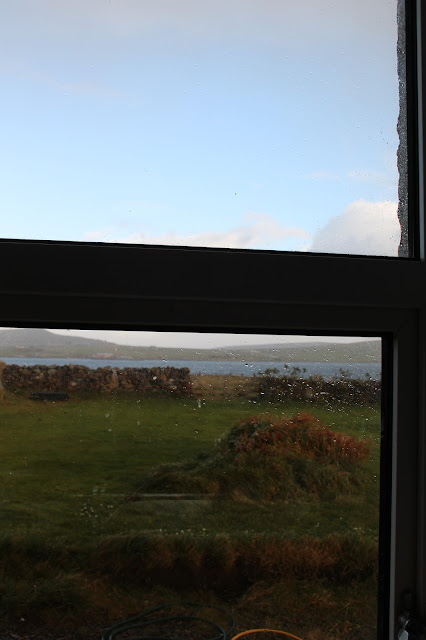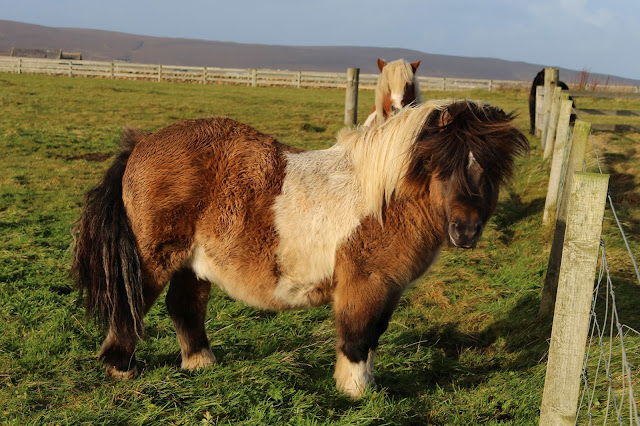Friday, October 28, 2016 ~ by Amy
Though we saw Shetland ponies near the
ferry terminal, we saw far more sheep than ponies as we drove around
the islands. There are thousands of sheep grazing the barren moors,
the peat bogs and the dry heather covered hills. There are fences,
but also frequent cattle guards and signs for sheep crossings. We
were told that prior to our arrival they had had little rain on the
islands so much of the land was brown and barren, including vast
areas that I came to find out are peat. There were also acres and
acres of closely cropped green pastures, all dotted with sheep of
many colors. At a glance many seem white but there are a variety of
colors and markings.
 |
| Colorful Shetland Sheep |
Hanging in our bedroom at The Bothy was
a framed poster of sheep markings. We ended up studying it instead
of sleeping one night, challenging each other on our proficiency with
the multiplication tables. According to the Shetland Sheep Society
there are eleven whole colours of sheep and more than thirty
recognized markings. That's a lot of variety! Here's a copy of that
photo that I found online.
 |
| Colors and varieties of Shetland Sheep |
I've always had a fondness for Shetland
ponies. When I was little we had a Shetland/Welsh pony named
“Tickles”. He was a spunky thing but I was very fond of him. My
mom made me a small stuffed pony with flexible legs attached with
buttons and a yarn mane and tail. The fleece fur was much the same
color as Tickle's and she even stitched on a star on his forehead
like Tickles had. I still keep him in my room fifty years later.
Here's what the official Shetland
website has to say about this sturdy breed of ponies, “For
at least 4000 years, in comparative isolation, these fascinating
small ponies have roamed the exposed hills and moors of Shetland.
From the 1840s, Shetland ponies began to be used in British coal
mines as new laws forbade the employment of women, girls and, later,
boys. Hardy, resilient and very strong for their size, the ponies
made ideal substitutes as they were able to pass through low
underground tunnels hauling truckloads of coal. At home, Shetland
ponies were used as workhorses - cultivating the land and
transporting peat from hills - an essential addition to crofting
families.
 |
| Wild looking island pony |
Shetland
ponies are foaled in the fields, live in the fields and die in the
fields. Ponies graze on hill ground, known locally as common grazing
or 'scattald'. The acres of rough heather clad moorland may appear
scant subsistence for any animal. However, Shetland ponies have
developed good conversion rates for food and high milk yield for
their foals. In some parts, where land and sea meet, the ponies can
supplement their diet with nutrients from mineral rich seaweed on
beaches. There is plenty of open space to roam freely and ponies can
seek natural shelter, if need be, behind hillocks, old stone walls or
peat banks.” www.shetland.org
After breakfast and several cups of
coffee, we bundled up in layers to go for a walk. First though, we
wanted to offer our squash peelings and leftover pasta to the
resident chickens. Alyssa brought a dishpan full outside. Our
hostess, Catriona, told us to just go out and say, “Here chooky,
chooky, chooky!”, and they'd come running. So we did. But long
before Alyssa could hand the chickens some food, the vicious wind
grabbed a pile of squash peels out and blew them across the grass!
 |
| Alyssa feeding the chickens |
We continued our walk around the Ordaal
farmyard and down to the sea. The wind ripped at our clothes and it
was almost impossible to stand up straight. Here, the North Sea
flows into a channel called the Balta Sound (hence, the very original
name for the village, Baltasound).
 |
| The sea flowing onto the land |
 |
| Balta Sound |
 |
| Sunshine on the sea and windblown grass |
 |
| These boots I bought from Costco have been indispensable |
 |
| Alyssa trying to hang onto her hood |
 |
| And the sunshine is back, but the windchill was still amazingly cold |
Looking back toward the house we could
better see how our 300 year old cottage tied in with the main house
(which was added on only 200 or so years ago!).
 |
| Bench...a perfect place to watch for the Northern Lights or the sea |
 |
| In the foreground, our 300 year old cottage |
 |
| Screen porch, our shared entrance to the main house |
Continuing our walk, we came across
this small stone marker near a fence. No idea what it says or
what/who it commemorates.
 |
| Stone marker |
There are four Shetland ponies pastured
adjacent to the farm. As soon as we approached, they came close to
nuzzle us and be scratched behind the ears.
 |
| Ordaal ponies |
Though all mares, a couple of the
ponies playfully nipped, kicked and reared up at each other, pawing
the air. I doubt they meant any harm but it showed their playful,
spunky side.
 |
| Dancing ponies |
When we could stand the cold wind no
longer, we went back to the cottage for a delicious lunch of ham and
cheese sandwiches.
 |
| Cottage door |
Since we planned on exploring the
island after lunch, we kept an eye on the rapidly changing weather.
 |
| Kitchen window |
 |
| View out the window of the sun and rain |
As we drove off, the sky opened up and
dumped on our car, nearly obliterating the landscape. Knowing it
would change, we followed our cutely drawn but rather faulty island
map and went to find us some castle ruins.
 |
| Map of Unst |






























No comments:
Post a Comment